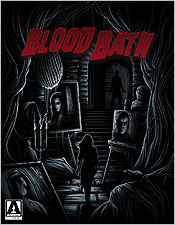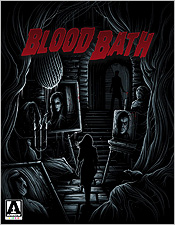Blood Bath (Blu-ray Review)

Director
Rados Novakovic/Michael Roy/Jack Hill and Stephanie RothmanRelease Date(s)
1963/1965/1966/1966 (May 30, 2016)Studio(s)
American International Pictures/Orion Pictures/MGM (Arrow Video)- Film/Program Grade: See Below
- Video Grade: See Below
- Audio Grade: See Below
- Extras Grade: B+
- Overall Grade: B+
Review
Blood Bath was released in 1966 by American International Pictures on a double bill with Queen of Blood. The movie’s convoluted production history makes it one of the most fascinating films of any era. Over the course of a decade, what began as a generic spy thriller morphed itself into a bit of a mindless vampire horror movie with sequences that damn near rival Ed Wood in terms of execution. Along the way, it found itself being made into no less than four different films and released at different times, all thanks to the combined efforts of Roger Corman and his various cast and crew at the time.
In the early 1960’s, Corman was looking to invest in movies from other countries, chiefly Russia. While he was busy doing that and personally directing other projects, he handed off duties to make a film in Yugoslavia to various cast and crew from their previous film Dementia 13. The resulting project, Operation Titian (known as Operacija Ticijan in Europe), featured a plot involving a man killing another man for a priceless painting, only to find that it has been replaced with a copy and that somebody has double-crossed him. Meanwhile, the police are looking for whomever is bumping off people related to the painting one by one. Later re-edited into Portrait in Terror, it tells pretty much the same story, but with different editing choices and a different score. The film was again reworked by Jack Hill into Blood Bath, this time shooting almost a completely new movie to go around various pieces of footage from the original shoot as a bit of a paean to A Bucket of Blood. Most of the new footage involves a painter who is turning into a vampire and murdering young women, albeit while a group of competing surrealist beatniks get in his way. Fledgling director and Corman assistant Stephanie Rothman took over Hill’s version before its release, and then later re-edited yet again with newly-shot sequences into Track of the Vampire. Each of the films (outside of Operation Titian) have been available for years in various ways, but this is the first time that all of them have been presented together in one place.
As far as the quality of each film is concerned, I originally found Operation Titian to be a bit of a slog to get through, and not just because it isn’t a horror film. The film is actually well-photographed, and it has some very few good editing choices, but it’s mostly just a boring movie. It seems to have no forward momentum, as well as very dated and ineffective musical cues. In retrospect, it’s still probably the best version of the story compared to what came later. Portrait in Terror is pretty much the same film, but just a bit slimmer with a different beginning and ending, a couple of extended scenes, and a different, more effective score. Still not an overly strong film, but some of the original sequences aided by the new score are a little more successful. Blood Bath is where the movie truly begins to take on a new life. Most of the original footage from both of the previous versions of the movie is now gone, with only pieces of it remaining. Surprisingly, almost all of the new footage was actually shot with actor William Campbell, who had already been in the previous versions. Track of the Vampire takes footage from all of the different versions of the movie, adding in two new sequences that don’t really have anything to do with the main plot, but follows the same through line as Blood Bath. A portion of the plot from Portrait in Terror involving Patrick Magee’s character has also been added back in, but with overdubs to try and utilize it in a different context.
When you get right down to it, there is no real definitive version of this movie. All of the versions have more cons than pros, and some versions are better than others. I personally feel that Operation Titian and Portrait in Terror are the better versions, overall, and even they aren’t all that amazing. They have a firm photographic stamp and style, even though their stories are a bit of a bore at times. But, most people looking in will likely be drawn to the horror versions included in this set, and I can certainly understand that. It was my original draw to it, as well. Yet, after watching them all back to back, it’s easy for me to see what is the most effective. It’s amazing to think that Roger Corman and the people under him would spend so much time trying to make a better movie out of only one, but since they did, we now have this fascinating behind the scenes look at a set of movies that changed both in story and style over time.
This Region A/B Limited Edition Blu-ray boxed set features all four versions of the film via 2K restorations, aside from Operation Titian, which is a complete reconstruction from the ground up. All of these various versions have been cobbled together from several different sources, including both HD and SD. Operation Titian’s presentation is the most rough-looking. All of its black and white levels vary from scene to scene, as does its contrast and brightness. There are some density issues, some crush, multiple scratches and lines running through the frame, and minor instability. It also features the aforementioned use of SD shots, as there are apparently no film prints available to cull them from. Portrait in Terror favors better, but features much of the same quality, minus the SD shots, obviously. Blood Bath has a stronger and more stable look overall, with less density issues, stronger blacks, and better brightness and contrast. It still features some of the aforementioned artifacts, however. Track of the Vampire is mostly identical, outside of the re-added sequences. Considering what Arrow Video had to work with, I think they pulled off an impossible job. We’re just lucky that these low budget movies haven’t disappeared entirely, or been destroyed. Judging them solely on their looks would do them an injustice, and I for one, applaud Arrow’s efforts. All four versions also feature an English mono LPCM soundtrack, as well. The sound in each of the films is decent, but don’t expect anything approaching fine quality. There’s noticeable hiss most of the time and dialogue is often hampered by distortion, as is the music and sound effects. However, dialogue is always easily understandable. The imperfections stick out more than most mono tracks presented on Blu-ray, but again, having it at all in any salvageable condition is worth the effort. All four versions also have subtitles in English SDH for those who might need them.
OPERATION TITIAN (FILM/VIDEO/AUDIO): C+/C+/C
PORTRAIT IN TERROR (FILM/VIDEO/AUDIO): C/B/C
BLOOD BATH (FILM/VIDEO/AUDIO): C+/B/C
TRACK OF THE VAMPIRE (FILM/VIDEO/AUDIO): C+/B/C
The supplemental materials include the terrific longform visual essay The Trouble with Titian: Revisited, an examination of Blood Bath and its various incarnations by author and "Video Watchdog" extraordinaire Tim Lucas. In all honesty, this video piece is much more interesting and entertaining than any of the films in this set and is worth the price tag alone. Also included is the Bathing in Blood with Sid Haig interview; the Jack Hill on Blood Bath interview; a still gallery; a double-sided fold-out poster with new artwork on one side and the original poster artwork on the other; and a limited edition 40-page insert booklet with essays on the film and its cast by Anthony Nield, Vic Pratt, Cullen Gallagher, and Peter Stanfield. Arrow Video originally announced that a set of outtakes for Track of the Vampire had been located and were to be included as an extra, but it turned out to actually be footage that was meant to be in the final film (as explained by Tim Lucas in the visual essay).
It’s been said before and it’ll be said again in the future, but Arrow Video is killing it with these amazing releases of absolutely obscure material. Blood Bath and its many other versions are no masterpieces by any stretch of the imagination, but having them all in the same package with the benefit of both hindsight and context makes this set a textbook example of how a film is shaped and formed over the course of a production... or in this case, productions. This is an amazing release, and definitely worth checking out if you’re into that sort of thing at all. Highly recommended.
- Tim Salmons

